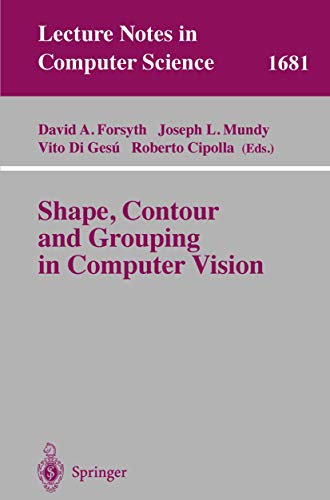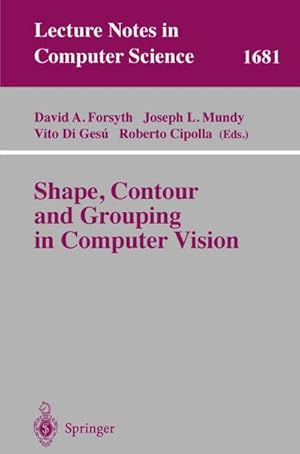shape contour grouping computer (13 Ergebnisse)
FeedbackSuchfilter
Produktart
- Alle Product Types
- Bücher (13)
- Magazine & Zeitschriften (Keine weiteren Ergebnisse entsprechen dieser Verfeinerung)
- Comics (Keine weiteren Ergebnisse entsprechen dieser Verfeinerung)
- Noten (Keine weiteren Ergebnisse entsprechen dieser Verfeinerung)
- Kunst, Grafik & Poster (Keine weiteren Ergebnisse entsprechen dieser Verfeinerung)
- Fotografien (Keine weiteren Ergebnisse entsprechen dieser Verfeinerung)
- Karten (Keine weiteren Ergebnisse entsprechen dieser Verfeinerung)
- Manuskripte & Papierantiquitäten (Keine weiteren Ergebnisse entsprechen dieser Verfeinerung)
Zustand Mehr dazu
- Neu (11)
- Wie Neu, Sehr Gut oder Gut Bis Sehr Gut (1)
- Gut oder Befriedigend (1)
- Ausreichend oder Schlecht (Keine weiteren Ergebnisse entsprechen dieser Verfeinerung)
- Wie beschrieben (Keine weiteren Ergebnisse entsprechen dieser Verfeinerung)
Einband
- alle Einbände
- Hardcover (Keine weiteren Ergebnisse entsprechen dieser Verfeinerung)
- Softcover (13)
Weitere Eigenschaften
- Erstausgabe (Keine weiteren Ergebnisse entsprechen dieser Verfeinerung)
- Signiert (Keine weiteren Ergebnisse entsprechen dieser Verfeinerung)
- Schutzumschlag (Keine weiteren Ergebnisse entsprechen dieser Verfeinerung)
- Angebotsfoto (4)
- Keine Print-on-Demand Angebote (11)
Sprache (1)
Preis
- Beliebiger Preis
- Weniger als EUR 20 (Keine weiteren Ergebnisse entsprechen dieser Verfeinerung)
- EUR 20 bis EUR 45
- Mehr als EUR 45
Gratisversand
Land des Verkäufers
Verkäuferbewertung
-
Shape, Contour and Grouping in Computer Vision
Anbieter: Biblios, Frankfurt am main, HESSE, Deutschland
EUR 31,12
Währung umrechnenEUR 2,30 für den Versand innerhalb von/der DeutschlandAnzahl: 1 verfügbar
In den WarenkorbZustand: New. pp. 364.
-
EUR 30,55
Währung umrechnenEUR 7,71 für den Versand von USA nach DeutschlandAnzahl: 1 verfügbar
In den WarenkorbZustand: New. pp. 364.
-
Shape, Contour and Grouping in Computer Vision
Anbieter: Majestic Books, Hounslow, Vereinigtes Königreich
EUR 29,28
Währung umrechnenEUR 10,23 für den Versand von Vereinigtes Königreich nach DeutschlandAnzahl: 1 verfügbar
In den WarenkorbZustand: New. pp. 364 49:B&W 6.14 x 9.21 in or 234 x 156 mm (Royal 8vo) Perfect Bound on White w/Gloss Lam.
-
Shape, Contour and Grouping in Computer Vision
Verlag: Springer Berlin Heidelberg, 1999
ISBN 10: 3540667229 ISBN 13: 9783540667223
Sprache: Englisch
Anbieter: moluna, Greven, Deutschland
EUR 48,37
Währung umrechnenKostenlos für den Versand innerhalb von/der DeutschlandAnzahl: Mehr als 20 verfügbar
In den WarenkorbKartoniert / Broschiert. Zustand: New.
-
Shape, Contour and Grouping in Computer Vision
Verlag: Springer Berlin Heidelberg, 1999
ISBN 10: 3540667229 ISBN 13: 9783540667223
Sprache: Englisch
Anbieter: AHA-BUCH GmbH, Einbeck, Deutschland
EUR 53,49
Währung umrechnenKostenlos für den Versand innerhalb von/der DeutschlandAnzahl: 1 verfügbar
In den WarenkorbTaschenbuch. Zustand: Neu. Druck auf Anfrage Neuware - Printed after ordering - Computer vision has been successful in several important applications recently. Vision techniques can now be used to build very good models of buildings from pictures quickly and easily, to overlay operation planning data on a neuros- geon's view of a patient, and to recognise some of the gestures a user makes to a computer. Object recognition remains a very di cult problem, however. The key questions to understand in recognition seem to be: (1) how objects should be represented and (2) how to manage the line of reasoning that stretches from image data to object identity. An important part of the process of recognition { perhaps, almost all of it { involves assembling bits of image information into helpful groups. There is a wide variety of possible criteria by which these groups could be established { a set of edge points that has a symmetry could be one useful group; others might be a collection of pixels shaded in a particular way, or a set of pixels with coherent colour or texture. Discussing this process of grouping requires a detailed understanding of the relationship between what is seen in the image and what is actually out there in the world.
-
Shape, Contour and Grouping in Computer Vision (Lecture Notes in Computer Science, 1681)
Anbieter: Ria Christie Collections, Uxbridge, Vereinigtes Königreich
EUR 60,53
Währung umrechnenEUR 5,76 für den Versand von Vereinigtes Königreich nach DeutschlandAnzahl: Mehr als 20 verfügbar
In den WarenkorbZustand: New. In.
-
Shape, Contour and Grouping in Computer Vision
Anbieter: Chiron Media, Wallingford, Vereinigtes Königreich
EUR 56,93
Währung umrechnenEUR 15,02 für den Versand von Vereinigtes Königreich nach DeutschlandAnzahl: 10 verfügbar
In den WarenkorbPF. Zustand: New.
-
Shape, Contour and Grouping in Computer Vision (Lecture Notes in Computer Science, 1681)
Anbieter: California Books, Miami, FL, USA
EUR 65,27
Währung umrechnenEUR 8,56 für den Versand von USA nach DeutschlandAnzahl: Mehr als 20 verfügbar
In den WarenkorbZustand: New.
-
Shape, Contour and Grouping in Computer Vision (Lecture Notes in Computer Science)
Anbieter: GuthrieBooks, Spring Branch, TX, USA
EUR 24,36
Währung umrechnenEUR 64,23 für den Versand von USA nach DeutschlandAnzahl: 1 verfügbar
In den WarenkorbPaperback. Zustand: Very Good. Ex-library paperback in very nice condition with the usual markings and attachments.
-
Shape, Contour and Grouping in Computer Vision (Lecture Notes in Computer Science, 1681)
Anbieter: Lucky's Textbooks, Dallas, TX, USA
EUR 52,52
Währung umrechnenEUR 64,23 für den Versand von USA nach DeutschlandAnzahl: Mehr als 20 verfügbar
In den WarenkorbZustand: New.
-
Shape, Contour and Grouping in Computer Vision: Lecture Notes in Computer Science (Lecture Notes in Computer Science (1681))
Anbieter: Mispah books, Redhill, SURRE, Vereinigtes Königreich
EUR 91,71
Währung umrechnenEUR 28,91 für den Versand von Vereinigtes Königreich nach DeutschlandAnzahl: 1 verfügbar
In den WarenkorbPaperback. Zustand: Like New. Like New. book.
-
Shape, Contour and Grouping in Computer Vision
Verlag: Springer Berlin Heidelberg, Springer Berlin Heidelberg Nov 1999, 1999
ISBN 10: 3540667229 ISBN 13: 9783540667223
Sprache: Englisch
Anbieter: buchversandmimpf2000, Emtmannsberg, BAYE, Deutschland
EUR 53,49
Währung umrechnenKostenlos für den Versand innerhalb von/der DeutschlandAnzahl: 1 verfügbar
In den WarenkorbTaschenbuch. Zustand: Neu. This item is printed on demand - Print on Demand Titel. Neuware -Computer vision has been successful in several important applications recently. Vision techniques can now be used to build very good models of buildings from pictures quickly and easily, to overlay operation planning data on a neuros- geon¿s view of a patient, and to recognise some of the gestures a user makes to a computer. Object recognition remains a very di cult problem, however. The key questions to understand in recognition seem to be: (1) how objects should be represented and (2) how to manage the line of reasoning that stretches from image data to object identity. An important part of the process of recognition { perhaps, almost all of it { involves assembling bits of image information into helpful groups. There is a wide variety of possible criteria by which these groups could be established { a set of edge points that has a symmetry could be one useful group; others might be a collection of pixels shaded in a particular way, or a set of pixels with coherent colour or texture. Discussing this process of grouping requires a detailed understanding of the relationship between what is seen in the image and what is actually out there in the world.Springer Verlag GmbH, Tiergartenstr. 17, 69121 Heidelberg 364 pp. Englisch.
-
Shape, Contour and Grouping in Computer Vision
Verlag: Springer Berlin Heidelberg Nov 1999, 1999
ISBN 10: 3540667229 ISBN 13: 9783540667223
Sprache: Englisch
Anbieter: BuchWeltWeit Ludwig Meier e.K., Bergisch Gladbach, Deutschland
EUR 80,24
Währung umrechnenKostenlos für den Versand innerhalb von/der DeutschlandAnzahl: 2 verfügbar
In den WarenkorbTaschenbuch. Zustand: Neu. This item is printed on demand - it takes 3-4 days longer - Neuware -Computer vision has been successful in several important applications recently. Vision techniques can now be used to build very good models of buildings from pictures quickly and easily, to overlay operation planning data on a neuros- geon's view of a patient, and to recognise some of the gestures a user makes to a computer. Object recognition remains a very di cult problem, however. The key questions to understand in recognition seem to be: (1) how objects should be represented and (2) how to manage the line of reasoning that stretches from image data to object identity. An important part of the process of recognition { perhaps, almost all of it { involves assembling bits of image information into helpful groups. There is a wide variety of possible criteria by which these groups could be established { a set of edge points that has a symmetry could be one useful group; others might be a collection of pixels shaded in a particular way, or a set of pixels with coherent colour or texture. Discussing this process of grouping requires a detailed understanding of the relationship between what is seen in the image and what is actually out there in the world. 364 pp. Englisch.






